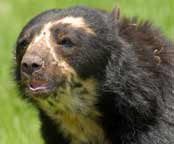
* BearLife.org * Polar Bears * Panda Bear * Koala * Grizzly Bear * Black Bear * Red Panda *
* Brown Bear * Kodiak Bear * Sun Bear * Kermode Bear * Sloth Bear * Moon Bear * Spectacled Bear * Bear Cruelty *
Spectacled Bear

- The spectacled bear is also known as the Andean bear. It is the only surviving member of the subfamily of “short-faced bears” from the last great Ice Age which roamed the territories of both North and South America.
-
Today the Andean bear lives in South America and is the only bear species to do so. It primarily inhabits dense rain forests and cloud forests at high altitudes in the Andes mountain range. They will travel to lower elevations to forage for food. They are found in parts of the following countries: Peru, Ecuador, Bolivia, Columbia, Venezuela, Panama, and Argentina.
-
The spectacled bear gets its name from its unique color pattern on its face. It has a white or cream colored pattern around its muzzle that extends below the face around its neck. The same color extends through the center of its face between the eyes and above to the top of the head extending to the sides. The pattern often resembles a pair of goggles or spectacles. Sometimes the area on the face or around the neck has a freckled or weaved appearance. Not all patterns are the same and some bears are more distinguished than others.
-
Spectacled bears have dark brown to black colored fur. They have short, round heads with a short muzzle. They have short semi-pointed ears on the top of their heads. Their body is small and compact, with a short neck compared to other bears. Combined with their unusual lighter facial colors, some bears resemble a (large) domestic calico cat.
-
Not one of the largest of the bear family, andean bear males weigh between 250 to 350 pounds. Females are usually under 160 pounds. They grow to be between 4 to 6 feet long.
-
They prefer to feed at night and are very reclusive. The areas that they live are remote and usually covered with dense vegetation. This makes it difficult to observe and gather detailed information about this shy species.
-
Spectacled bears are omnivorous. Their preferred diet is fruits and bromeliads. They are confident tree climbers and will traverse tree branches to gather their favorite foods. Bromeliads often grow in clumps on tree branches and on the forest floor. They methodically dissect the plants with their claws and dine on the fibrous leaves and centers. They also eat bugs, rodents, small animals, eggs, and nesting birds.
-
Sleeping nests will often be constructed in tree branches using bent branches, twigs, leaves, and grass. They may use these nests for several weeks if trees in the area have abundant fruits or bromeliads. When they’ve had their fill they move on to new feeding areas.
-
Mating season is between the months of April to July. The spectacled bear is solitary but male and female will meet and stay together for up to one week during breeding. However the male does not participate in raising newborn cubs.
-
Cub litter size ranges from 1 to 4 although 2 is the most common. They are born in the late winter up to the month of February.
-
Exact population figures are unknown. It is estimated there are under 2400 remaining in the wild. The spectacled bear is listed on the IUCN List of Threatened Animals (status: vulnerable)
Bears * About Us * Contact Us * Bear Cruelty
